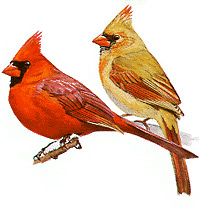Blog - General
Christmas for the Cardinals
Can anything beat the sight of a bright red Cardinal against a backdrop of white snow? As a resident from the  Eastern U.S to the Great Plains, the Northern Cardinal is a faithful visitor to feeders and can be one of the easier species to attract. It is such a popular and widespread species throughout the east, that it is the state bird for seven states and the mascot for professional baseball and football teams.
Eastern U.S to the Great Plains, the Northern Cardinal is a faithful visitor to feeders and can be one of the easier species to attract. It is such a popular and widespread species throughout the east, that it is the state bird for seven states and the mascot for professional baseball and football teams.
The Cardinal’s heavy triangular beak is red, contrasted by a black throat on the male. Their name comes from the red robes worn by Roman Catholic cardinals. The female is brownish overall with reddish highlights on the wings and tail. In the summer, dark beaked juvenile birds come in a variety of “half-baked” plumages, with a mixing and mottling of red and brown. The crested head is another good field mark for adults and may be missing or shaggy on the juveniles.
Spring through fall their clear slurred and whistled song “cheer, cheer, cheer” or “pretty-pretty-pretty-birdie-birdie-birdie” rings throughout the landscape, with females joining the singing too. Year round, listen for their incessant, short metallic calls and occasional bursts of song.
Since Cardinals are larger birds they prefer a larger perching area. Hanging or post mounted platform feeders are ideal. From my experience, this style of bird feeder is used by Cardinals most often – probably because of its large flat surface, and the birds feel very safe since they can see in all directions. Ground bird feeders are another style which Cardinals seem to approve of. But since squirrels are an issue in my yard I use a mix of Safflower seed and white Proso millet on all my ground feeders. Hopper style feeders with a large perching area work great as well. The advantage here is they have the capacity to hold a quantity of bird seed, requiring fewer trips to fill them.
Their diet consists primarily of seeds and berries supplemented by insects, especially during the breeding season. Preferred seeds include sunflower, safflower and peanut parts which are coincidentally the ingredients of our Cardinal Blend. They prefer feeding on or near the ground and are often the first to arrive at feeders in the morning and the last to leave at the end of the day.
Cardinals live in a wide variety of habitats including woodland edges, thickets, forests, swamps, urban areas and gardens. They are typically seen alone or in small groups. To encourage nesting, plant vines, thickets, and fruit-bearing shrubbery. During the courtship process, the male will feed seeds to the female. This also prepares him to take care of the young birds while she starts another nesting cycle.
